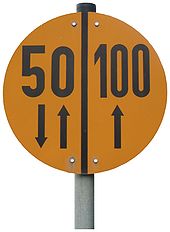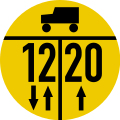Military load class


The military load class ( English Military Load Classification , abbreviated: MLC ) or MLC class is a weight classification for military vehicles of the NATO , which is determined in Germany by the Federal Office for Equipment, Information Technology and Use of the Bundeswehr . It corresponds roughly to the actual weight in American tonnes ( short tons ); the center distance, width and height of the vehicle and the support ratio (e.g. for the chains of a tank) are also included in the determination of the MLC. On bridges and roads with limited load-bearing capacity , signs indicate which load class they can safely drive on.
Identification of vehicles
Vehicles over three tons are marked with an MLC in the Bundeswehr . Until the early 1980s, this was done using black numbers on a yellow circle, now using white letters on a black circle. The marking must be attached to the front of the vehicle. The MLC is painted on vehicles with largely the same weight; on trucks , especially transport vehicles, changing digits are used or the actual load class is recorded with chalk. For vehicle combinations such as B. Articulated lorries or trucks with trailers, the individual class is indicated on the right-hand side of the vehicle and the total of the individual classifications on the front of the vehicle; this is also indicated by a "C" (combination).
Marking of bridges
Due to NATO requirements, the bridges in the Federal Republic of Germany were marked with a circular, yellow sign during the Cold War (sometimes referred to as the NATO bridge sign ). The sign indicates the maximum MLC the bridge is allowed to drive on and the military traffic load for which the bridge was designed. A distinction is made between wheeled and tracked vehicles and whether traffic takes place in both or in only one direction. In one-way traffic, there must be a minimum distance of 100 feet (around 30 m) between vehicles .
| class | Caterpillars | Wheeled vehicles |
|---|---|---|
| 40 | 36.3 t | 42.6 t |
| 50 | 45.4 t | 52.6 t |
| 80 | 72.6 t | 83.5 t |
| 100 | 90.7 t | 104.3 t |
| 120 | 108.9 t | 125.2 t |
Marking of bridges with military traffic signs:
Current situation
Since 2009 the Federal Ministry of Defense no longer stipulates the placement of the signs; existing signs do not have to be removed. The new federal states were not allowed to be signposted until 1995 due to the two-plus-four contract . This is still the case today. The MLC signs are therefore one of the last visible signs of the former division of Germany in road traffic.
literature
The requirements for the military load classes are set out in the NATO Standardization Agreements :
- STANAG 2010, Military Load Classification Markings.
- STANAG 2021, Military Load Classification of Bridges, Ferries, Rafts and Vehicles.
Web links
- STANAG 2021, Military Load Classification of Bridges, Ferries, Rafts and Vehicles , NATO standard that defines the military load classes (only the cover sheet, the standard itself is secret)
- Bernd Brandt: On the classification and dimensioning of bridges according to STANAG 2021 , special print from: Beton- und Stahlbau 4 (1990), pp. 91–98 ( Memento of May 24, 2005 in the Internet Archive )
- panzerbaer.de - camouflages and markings of vehicles of the Bundeswehr - marking of the Military Loading Class (MLC)
Individual evidence
- ↑ John Pike: FM 3-34.343 Appendix B. Retrieved on October 30, 2018 (English): "The weight of the tracked vehicle in short tons was chosen as the classification number. A single-wheeled vehicle has a weight greater than its classification number. "
- ↑ Antonia Kleikamp: Cold War: Why the armored shields of NATO are disappearing . In: THE WORLD . November 26, 2013 ( welt.de [accessed October 30, 2018]).








